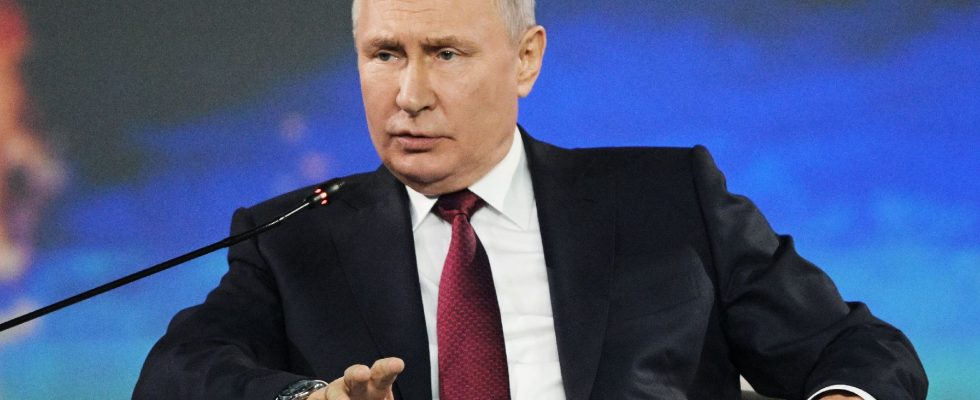It’s an endless nightmare that has haunted Vladimir Putin’s nights since he came to power. In 1989, the USSR counted nearly 287 million inhabitants, well ahead of the United States. Stripped of former Soviet republics, the Russian Federation peaked in 1994 at 149 million people. In 2021, there were only 145 million Russians left, compared to 331 million Americans and 1.4 billion Chinese. Before the Federal Assembly in 2006, Putin had for once not lied when he described demography as “the most acute problem of present-day Russia”.
At that time, the Kremlin thought it had found the solution. After a fall in births in the 1990s, specific to all the countries of the former Soviet bloc, these rose again in the 2000s. Putin then instituted an expensive pronatalist policy, with financial aid for parents as soon as they were born. second child, while celebrating conservative and family values. In 2015, the fertility rate rebounded to 1.8 children per woman. Associated with economic immigration from the countries of the former Soviet Union, it allows a time to halt the decline of the population.
But the birth curve ended up plunging again (1.5 children per woman). “As often with pronatalist policies, there was an opportunity effect, notes demographer Alain Blum, director of research at INED. People rushed to have children. But they did the number of babies they wanted, and then stopped. Moreover, the discourse on the return to traditional values is very artificial, and does not correspond to the evolution of Russian society.”
gender imbalance
The problems go far beyond the cradle alone. Russia is in no way Japan, also in demographic decline, but with the highest life expectancy in the world. For Nicholas Eberstadt, economist at the American Enterprise Institute, it has everything of a “mystery” by combining a high level of education, comparable to OECD states, and a mortality that places it among the least developed countries. (PMA). Russian life expectancy, which had bottomed out in the mid-1990s (64 years), has certainly seen a marked upturn since the mid-2000s, reaching a peak of 73 years in 2019. But even this year- there, the life expectancy for a 15-year-old Russian male was at the level of…Haiti. “In poor countries, the main causes of death are infectious diseases or those related to poverty and malnutrition. But in Russia, the main causes of death are related to cardiovascular diseases and injuries, which includes suicides, murders, accidents…”, deciphers Eberstadt. The consumption of alcohol, and in particular vodka, is undoubtedly not for nothing in this sad Russian exception.
Since then, the Covid-19 has been catastrophic for the country. The official figures (less than 400,000 dead) are largely underestimated. According to the magazine’s calculations The Economist, between 2020 and 2023 there would have been a surplus of 1.2 to 1.6 million deaths, with the highest mortality rate in the world during the pandemic. Even if Putin aims to “Russify” the conquered populations, the war in Ukraine is for the moment only aggravating the demographic crisis. Nearly 200,000 soldiers were probably killed on the front lines, and between 500,000 and 1 million people, mainly young educated men, fled the country. “As it concerns men aged 20 or 30, the deaths in Ukraine will inevitably have an impact on life expectancy, which could drop by one or two years, estimates Alain Blum. On the other hand, we do not yet know the effects on the birth rate, because when men go to war, they can also rush to get married and have children”. What also accentuate the imbalance between the sexes, one of the largest in the world, with a surplus of 10 million women compared to men.
For Nicholas Eberstadt, “Putin has a strange approach to population policy. He’s a bit like a rancher who thinks it’s more important to have a high number of cattle than to have a healthy herd. and value. Thus he carried out a policy aimed at increasing births and the number of Russian citizens, up to stealing people from other territories. The annexation of Crimea allowed him to add 2.3 million inhabitants to the Russian Federation. But Putin pays very little attention to human capital.”
25 million fewer inhabitants in 50 years
Even the national agency Rosstat does not envisage that the number of births could again exceed that of deaths in the decade to come. According to UN projections, the country could lose 25 million inhabitants in fifty years, which would relegate it to 15th place in the world. But this is not the worst-case scenario for the Kremlin. As Alain Blum underlines, the decrease in internal migratory flows within the Russian Federation increases the risks of secession: “Today, the Siberian population is born on the spot. The fact of feeling more Siberian than Russian can be a danger for the coherence of the country. It is clear that in a republic like that of Yakutia, autonomy is a real possibility, especially since the mining revenues are very largely transferred to the central power.”
Country which is emptying of its inhabitants, fragmentation of the empire… Putin’s nights are not likely to improve from a demographic point of view. If it seeks to offset this inevitable decline with an increasingly aggressive foreign policy, the Russian regime will one day have to come to terms with it. “This contradiction between Russia’s geopolitical ambitions and the reality of its means cannot continue forever, assures Nicholas Eberstadt. The country will become a middle power at the world level. But will this transition be done peacefully or in a violent?”
